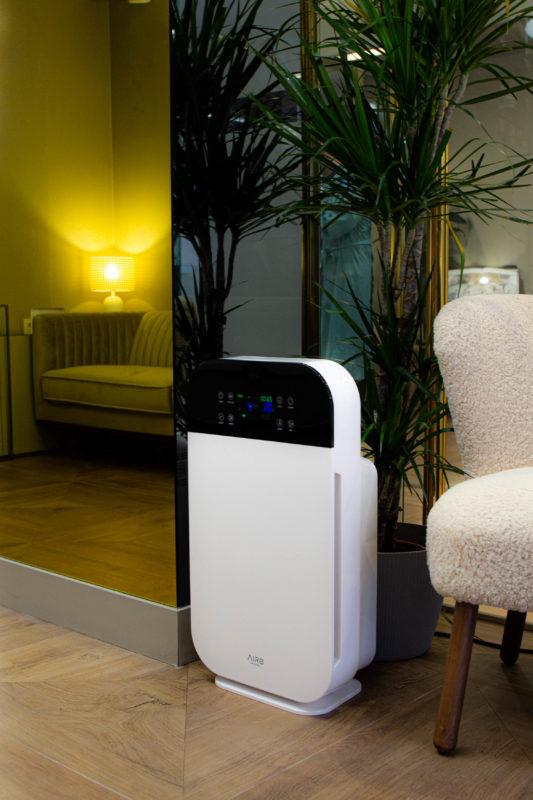The type of filter
On behalf of the BSS, the Institute for Sensor and Actor technology at the Coburg University of Applied Sciences tested various air purifiers in early 2021, which are suitable for most locations and their acquisition costs are between approx. 300 to 1,500 euros.
Air cleaners only reduce loads if they effectively filter viruses with a high efficiency from the air.As the measurements of the BSS device test showed at eleven room fans, filters of class E12 are sufficient.Devices that have HEPA H13 filters are optimal.Better filters such as H14 or U15 are not necessary and cause avoidable higher costs.
How many devices are needed?
The number of devices required depends on the size of the room and the use of space.When choosing, do not rely on the information from manufacturers for which room area the devices are suitable.These calculations are only very large information, because the space volume is decisive and this depends on the height of the room.
Do you need one or more devices with low volume, e.g.For example, since these are to be operated in an office or in a waiting room, then you should first calculate the room volume (= surface x ceiling height) and strive with the device at least 3 times an hour.If you have a room with 20 m² and 2.5 m high, the device would have to filter 150 m³ /hour of air.As the next step, check which performance level the device would have to be operated and with what volume it runs when operating in this level.If it is too loud at the required level, the operation of two devices with a lower level is recommended.
Two devices were selected for the arithmetic examples, for which there are testable information on noise and volume flow.(Room with 20 m² and 2.5 m height = device 150 m³ /hour air)

Calculation example 1: The device from Philips (4000i) has an air flow of 510 m³/h.This would be sufficient for their room (20 m² and 2.5 m height).However, the volume with 65 dB (A) at this level is too high for normal rooms.In any case, this device is significantly quieter on the smallest level, but then only brings 83 m³/hour of filtered air.Thus, two devices would be required for level 1.However, if information about the noise development at low levels is missing, as it is the case here, you should either request a device for a sample in order to check the volume on site, or request binding information about noise at the lowest level and check whether and check whetherThis does not reach more than approx. 40 dB (A).
Calculation example 2: For the IQAIR 100, the manufacturer for level 3 specifies a volume of 170 m³/hour and a volume of 41 dB (A).The noise development would therefore still be acceptable and the volume output would be sufficiently high.Although the device was not tested at level 3, only level 1, 4 and 6. However, since all information from the manufacturer was confirmed during the test, there is no reason to doubt the manufacturer's information for operation at level 3.
The optimal place
Smaller, cheaper and quieter devices are usually more suitable for normal large rooms.But even in large rooms, setting up several smaller devices is more sensible than just a large, heavy and mostly loud device.The air purifiers are supposed to prevent the transfer from one person to another person and this should reduce the concentration of viruses at the same time in several places and not “centrally” in one place.The size of a room alone is not enough to properly assemble devices.For several people in the room, the devices should be set up so that the devices work like an air barrier between the people.With an office with four desks and four people, a device positioned in the tables in the axis cross should look good.However, if there are six or eight jobs in the room, two devices would be advisable.
What is often not considered is the noise.Devices that provide the air throughput required for a certain room only with high noise development are not suitable for rooms in which normal office work, lessons or medical care takes place.The noise development should be at a low, non -disturbing level at the operating level, which provides the required volume flow.In the case of offices or comparable rooms, a sound power level of up to 40 dB (A) is optimal, 45 dB (A) would still be acceptable.
What must be considered before purchasing?
Before the purchase, the BSS recommends checking the following aspects on site, as well as the technical data and properties to be questioned:
The entire price-performance ratio must be taken into account with a view to follow-up costs through filter exchange, whereby it can be assumed that larger-dimensioned filters should have a longer service life than small filters and the bottom line may cause less costs than filters and devices thatare initially cheaper when shopping.
As the BSS device test shows, high -quality air purification devices are already available in the price range between 500 euros and 1,200 euros on the market and can be used in normally used apartments or commercial rooms.These include, for example, medical practices, physiotherapists, as well as hairdressing shops, nail and tattoo studios, customer and meeting rooms from banks, tax consultants, notaries, insurance offices, but also smaller retail stores, to name just a few.
Additional functions on the air purifier
Several manufacturers offer devices with "additional functions" such as UV radiation or ionizers.This is superfluous.If almost 100 percent of the viruses are filtered out of the air, nothing has to be irradiated with UV light.However, noteworthy quantities with the filtered air should get back into the room, because e.g.B. the effect of the built-in filters is not satisfactory, and it is therefore also irradiated with UV light, it is critical to ask whether infectious germs are actually "killed" by UV radiation.The air flows through the device at high speed.It is questionable whether the very short exposure time of the UV light is sufficient to destroy viruses or other germs and, if so, the percentage of viruses are destroyed.
Source: Federal Association of Schimmelwilzsanierung e.V. (BSS) / Delia Roscher











Test winner at Stiftung Warentest:...
How to get the perfect look for Cos...
Dry elbows: This is how brittle ski...
Cream for Rosacea: The Best Creams